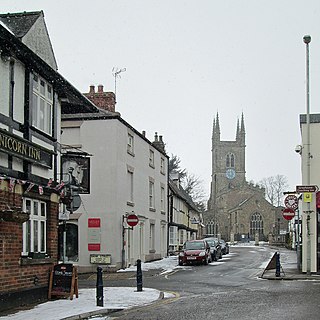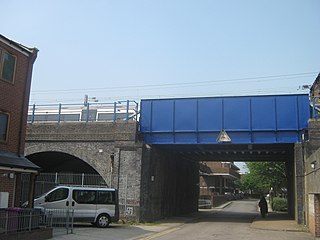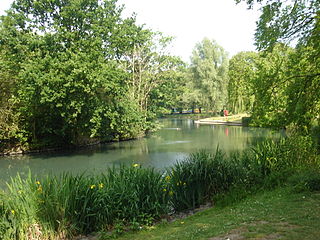
Carshalton is a town, with a historic village centre, in south London, England, within the London Borough of Sutton. It is situated 9.5 miles (15.3 km) south-southwest of Charing Cross, in the valley of the River Wandle, one of the sources of which is Carshalton Ponds in the middle of the village. Prior to the creation of Greater London in 1965, Carshalton was in the administrative county of Surrey.

Welling is an area of South East London, England, within the London Borough of Bexley and the boundaries of the historic county of Kent. It is 1.5 miles (2.4 km) west of Bexleyheath, 4 miles (6.4 km) south east of Woolwich and 10.5 miles (16.9 km) east-southeast of Charing Cross, the traditional centre of London.

Thomas John Barnardo was an Irish-born philanthropist and founder and director of homes for poor and deprived children. From the foundation of the first Barnardo's home in 1867 to the date of Barnardo's death, nearly 60,000 children had been taken in.

Lutterworth is a market town and civil parish in the Harborough district of Leicestershire, England. The town is located in southern Leicestershire, close to the borders with Warwickshire and Northamptonshire. It is located 6.4 miles north of Rugby, Warwickshire and 12 miles south of Leicester.

New Kent Road is a 1 kilometre (0.6 mi) road in the London Borough of Southwark. The road was created in 1751 when the Turnpike Trust upgraded a local footpath. This was done as part of the general road improvements associated with the creation of Westminster Bridge; in effect it was possible to travel from the West End/ Westminster to the south-east without having to go via the Borough of Southwark but could now cross St George's Fields to the junction of Newington Causeway and Newington Butts which is where New Kent Road starts at Elephant and Castle. The route runs eastward for a few hundred yards to the junction of Great Dover Street and Tower Bridge Road, known as Bricklayers Arms, where it joins the original route to the south-east Old Kent Road.

Bromley, commonly known as Bromley-by-Bow, is a district in the London Borough of Tower Hamlets in East London, located on the western banks of the River Lea, in the Lower Lea Valley in East London.

Mile End is a district in the East End of London, England, 3.6 miles (5.8 km) east-northeast of Charing Cross. Situated on the London-to-Colchester road, it was one of the earliest suburbs of the City of London. It became part of the metropolitan area in 1855, and is connected to the London Underground.

Barnardo's is a British charity founded by Thomas John Barnardo in 1866, to care for vulnerable children. As of 2013, it raised and spent around £200 million each year running around 900 local services, aimed at helping these same groups. It is the UK's largest children's charity, in terms of charitable expenditure. Its headquarters are in Barkingside in the London Borough of Redbridge.

Tower Hamlets Cemetery Park is a local nature reserve and historic cemetery in the London Borough of Tower Hamlets within the East End of London. It is regarded as one of the seven great cemeteries of the time.

Mile End Park is a park located in the London Borough of Tower Hamlets. It is a linear park of some 32 hectares, and was created on industrial land devastated by World War II bombing. Some of the park is within Limehouse and Globe Town, with the park lying on land to the east of the Regent's Canal. In the north, it is separated from the southern edge of Victoria Park by the Hertford Union Canal. It is open 24 hours a day.

The Parkland Walk is a 3.1-mile (5.0 km) linear green pedestrian and cycle route in London, which follows the course of the railway line that used to run between Finsbury Park and Alexandra Palace, through Stroud Green, Crouch End, Highgate and Muswell Hill. It is often mistakenly described as 4.5 miles long, but even taking in the gap between the two sections it still only totals 3.1 miles (5.0 km). The route follows the bridges and cuttings of the line, but avoids the closed surface section of Highgate station and its adjoining tunnels, which are closed to walkers for safety reasons. The walk is almost all in Haringey, but a short stretch between Crouch Hill and Crouch End Hill is in Islington and this section incorporates Crouch Hill Park.

Ragged schools were charitable organisations dedicated to the free education of destitute children in 19th century Britain. The schools were developed in working-class districts. Ragged schools were intended for society's most destitute children. Such children, it was argued, were often excluded from Sunday School education because of their unkempt appearance and often challenging behaviour. The London Ragged School Union was established in April 1844 to combine resources in the city, providing free education, food, clothing, lodging and other home missionary services for poor children. Although the London Ragged School Union did not extend beyond the metropolis, its publications and pamphlets helped spread ragged school ideals across the country. They were phased out by the final decades of the 19th century.

Hutton is an area of Brentwood in south Essex. It has good links to Central London via Shenfield train station which is just 1 mile (1.6 km) from Hutton. Brentwood town centre lies 3 miles to the west. The area can be split between modest housing estates and the largely affluent Hutton Mount. There are two wards named "Hutton" both in the Borough of Brentwood.

Stepney Causeway is a street in Stepney, in the East End of London. It runs north–south between the A13 road and the B126 Cable Street. It is crossed by a railway bridge carrying the Docklands Light Railway and c2c line out of Fenchurch Street railway station. The street is particularly associated with Thomas John Barnardo, who opened his first shelter for homeless children at No 18.

Pymmes Park is located in Edmonton, London and is bordered by the North Circular Road.

The British Schools Museum is an educational museum based in original Edwardian and Victorian school buildings in Hitchin in Hertfordshire, England. The museum complex is made up of Grade II listed school buildings housing infants, girls and boys schools with houses for Master and Mistress. It includes a monitorial schoolroom based on the educational theories of Joseph Lancaster for 300 boys, which opened in 1837, and a rare galleried classroom, dating from 1853.

Grants of Croydon is an entertainment complex at 14–32 High Street, Croydon, London. Originally built in 1894, Grants became a Grade II listed building in 1990. In 2000 Grants was re-developed into an entertainment centre. It was bought by Scottish Widows in early 2010.

Government Offices Great George Street (GOGGS) is a large UK government office building situated in Westminster between Horse Guards Road, Great George Street, Parliament Street, King Charles Street and Parliament Square. The western end of the building, on Horse Guards Road, is known as 1 Horse Guards Road (1HGR). The Parliament Street end is referred to as 100 Parliament Street (100PS).

Beaconsfield is an artist-run gallery situated in Vauxhall, south London, England. It occupies a Victorian building consisting of the southern wing of the former original Lambeth ragged school.

The Memorial to Dr Barnardo by George Frampton, at Barkingside in the London Borough of Redbridge, commemorates the founder of the Barnardo's children's charity. Born in Dublin into a Sephardic Jewish family, Thomas John Barnardo moved to the East End of London in 1866 where he established a chain of orphanages that developed into the Barnardo's charity. He died in 1905 and, in a move unusual for the time, was cremated; his ashes were interred in front of Cairn's House, the original building of his Barkingside children's village. In 1908, a memorial was raised on the site, the sculpture being undertaken by George Frampton, who worked without a fee. The memorial was designated a Grade II listed structure in 1979 and upgraded to II* in 2010.



















